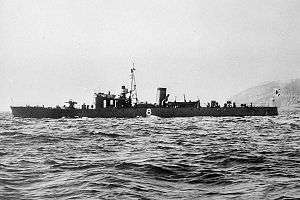CH-4-class submarine chaser
 No.8 in 1938 | |
| Class overview | |
|---|---|
| Name: | No.4 class submarine chaser |
| Builders: |
|
| Operators: | |
| Preceded by: | No.3 class |
| Succeeded by: | No.13 class |
| Cost: | 1,579,000 JPY |
| Built: | 1937 – 1939 |
| In commission: | 1938 – 1960 |
| Planned: | 9 |
| Completed: | 9 |
| Lost: | 7 (or 6)[1] |
| Retired: | 2 (or 3)[1] |
| General characteristics | |
| Type: | Submarine chaser |
| Displacement: |
|
| Length: |
|
| Beam: | 5.6 m (18 ft 4 in) |
| Draught: | 2.1 m (6 ft 11 in) |
| Propulsion: | 2 × Kampon Mk.22 Model 6 diesels, 2 shafts, 2,600 bhp |
| Speed: | 20.0 knots (23.0 mph; 37.0 km/h) |
| Range: | 2,000 nmi (3,700 km) at 14 kn (16 mph; 26 km/h) |
| Complement: | 59 |
| Armament: |
|
The No.4 class submarine chaser (第四号型駆潜艇, Dai 4 Gō-gata Kusentei) was a class of submarine chasers of the Imperial Japanese Navy (IJN), serving during and after World War II. 9 vessels were built in 1937-39 under the Maru 3 Programme.
Design
- Project number was K7. The No.4 class submarine chaser was reinforced model of the No.3 class. They lifted freeboard. Other general placement were same as No.3 class.
- Their design was elaborate, because the Navy Technical Department (Kampon) devoted itself to making them small. However, their designs were not able to accept the reinforcement of anti-aircraft guns and depth charges.
Ships in class
| Ship # | Ship | Builder | Laid down | Launched | Completed | Fate |
| 62 | No.7[2] | Tsurumi Iron Works | 30 October 1937 | 10 June 1938 | 15 November 1938 | Sunk by aircraft at east of Car Nicobar on 11 April 1945. |
| 63 | No.8 | Tama Shipyards | 10 January 1938 | 9 August 1938 | 30 November 1938 | Sunk by HMS Trenchant and HMS Terrapin at Strait of Malacca on 4 March 1945. |
| 64 | No.4 | Ōsaka Iron Works, Sakurajima Factory | 19 January 1938 | 13 September 1938 | 28 December 1938 | Struck a naval mine and sank at Surabaya on 13 August 1945. |
| 65 | No.5 | Mitsubishi, Yokohama Shipyard | 25 January 1938 | 28 July 1938 | 6 December 1938 | Scuttled by Royal Navy off Singapore on 11 July 1946. Decommissioned on 10 August 1946. |
| 66 | No.11 | Tsurumi Iron Works | 19 January 1938 | 28 June 1938 | 2 February 1939 | Sunk by aircraft at west of Buka Island on 6 November 1943. |
| 67 | No.12 | Tama Shipyards | 15 July 1938 | 8 February 1939 | 30 April 1939 | Probably sunk by USS Bluegill east of Mindanao on 13 August 1944.[1] Decommissioned on 30 September 1945. |
| 68 | No.10 | Ōsaka Iron Works, Sakurajima Factory | 16 September 1938 | 31 January 1939 | 15 June 1939 | Aground at Angaur on 2 May 1944. Later scuttled. |
| 69 | No.9 | Mitsubishi, Yokohama Shipyard | 10 May 1938 | 15 October 1938 | 9 May 1939 | Decommissioned on 20 December 1945. Surrendered to Republic of China on 3 October 1947, and renamed Haida. Renamed Fuling (PC-107) in January 1951. Renamed Minjiang in 1954. Decommissioned ni 1960. |
| 70 | No.6 | Tsurumi Iron Works | 5 July 1938 | 6 February 1939 | 20 May 1939 | Heavy damaged by aircraft at Palau on 30 March 1944. Later sank in shallow water. |
Footnotes
- 1 2 3 Another opinion: The No.12 was survived war at Palau.
- ↑ Submarine chaser No.7 (第7号駆潜艇 Dai 7 Gō Kusentei). The same shall apply hereinafter.
Bibliography
- Ships of the World special issue Vol.45, Escort Vessels of the Imperial Japanese Navy, "Kaijinsha"., (Japan), February 1996
- The Maru Special, Japanese Naval Vessels No.49, Japanese submarine chasers and patrol boats, "Ushio Shobō". (Japan), March 1981
- "Japanese Subchasers". Combinedfleet.com.
This article is issued from Wikipedia - version of the 10/8/2015. The text is available under the Creative Commons Attribution/Share Alike but additional terms may apply for the media files.